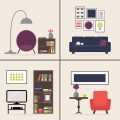1. The Importance of Work-Life Harmony in Modern Office Design
In today’s fast-paced world, maintaining a balance between work and personal life has become more challenging than ever. With many professionals spending a significant portion of their day in the office, the design of these spaces plays a crucial role in promoting well-being and productivity. A thoughtfully designed workplace can help employees feel more comfortable, reduce stress, and create an environment that supports both professional and personal fulfillment.
How Office Design Impacts Work-Life Balance
The way an office is structured and furnished directly affects employees ability to manage their time effectively and maintain a sense of balance. Poorly designed spaces can lead to increased stress, fatigue, and decreased efficiency. On the other hand, offices that prioritize comfort, flexibility, and aesthetics can contribute to a more positive work experience.
Key Elements of a Harmonious Office Environment
To foster a balanced work-life dynamic, modern offices should incorporate elements that promote well-being. Below are some essential factors to consider:
| Element | Impact on Work-Life Balance |
|---|---|
| Flexible Workspaces | Allows employees to choose where and how they work, reducing stress and enhancing focus. |
| Natural Lighting | Boosts mood, improves sleep patterns, and enhances overall productivity. |
| Comfortable Seating | Reduces physical strain and promotes long-term health benefits. |
| Quiet Zones | Provides areas for focused work or relaxation, helping employees recharge. |
| Breakout Spaces | Encourages social interaction and mental breaks, fostering creativity. |
The Growing Need for Thoughtful Office Design
As remote work becomes more common and expectations for workplace wellness rise, businesses must rethink their office layouts. Employees seek environments that support not only their professional tasks but also their overall well-being. Companies that invest in thoughtful office design can enhance employee satisfaction, improve retention rates, and create a more engaged workforce.
A well-designed workspace should be more than just functional; it should inspire productivity while allowing employees to maintain a healthy balance between their work responsibilities and personal lives. By prioritizing these aspects in office design, organizations can create an environment where professionals thrive both professionally and personally.
2. Creating a Functional Yet Comfortable Workspace
Designing an office that balances productivity and comfort requires thoughtful planning. A well-designed workspace can enhance focus, reduce stress, and improve overall well-being. By incorporating ergonomic furniture, proper lighting, and flexible layouts, you can create an environment that supports both efficiency and relaxation.
Ergonomic Furniture for Better Posture
Investing in ergonomic furniture is essential for a comfortable workspace. Sitting for long hours in an unsupportive chair or working at an improperly positioned desk can lead to discomfort and even long-term health issues. Here are some key ergonomic elements to consider:
| Furniture | Features |
|---|---|
| Ergonomic Chair | Adjustable height, lumbar support, breathable material |
| Standing Desk | Height adjustability to switch between sitting and standing |
| Keyboard & Mouse | Wrist support, natural hand positioning |
| Monitor Placement | Eye-level positioning to reduce neck strain |
Optimizing Lighting for Productivity and Comfort
Lighting plays a crucial role in maintaining focus and reducing eye strain. A mix of natural and artificial lighting creates a balanced atmosphere that enhances work efficiency while preventing fatigue.
Natural Light
Position your desk near windows to maximize daylight exposure. Natural light boosts mood and energy levels, making it easier to stay productive throughout the day.
Artificial Lighting
If natural light is limited, use adjustable LED desk lamps with warm or cool settings. Avoid harsh fluorescent lighting, as it can cause headaches and eye discomfort.
Flexible Layouts for Versatility
A rigid office layout can feel restrictive and uninspiring. Instead, incorporate flexibility into your design by using modular furniture and multi-purpose spaces that adapt to different tasks.
Open vs. Private Spaces
A combination of open collaboration areas and quiet zones allows for both teamwork and focused work. Use room dividers or bookshelves to create separation without making the space feel closed off.
Break Areas for Relaxation
A designated break area encourages short mental resets throughout the day. Comfortable seating, plants, and a coffee station can make breaks more refreshing.
The Balance Between Functionality and Comfort
Your office should be both efficient and inviting. By blending ergonomic design, proper lighting, and flexible layouts, you can create a workspace that promotes productivity without sacrificing comfort.
![]()
3. Blending Residential Comfort with Professional Efficiency
Creating an office that balances the warmth of home with the functionality of a professional setting can significantly enhance employee well-being and productivity. By integrating home-like elements into office design, businesses can foster a welcoming atmosphere without sacrificing efficiency.
The Role of Comfort in Workplace Productivity
A comfortable work environment encourages employees to feel more relaxed and engaged, leading to improved focus and job satisfaction. Simple design choices like ergonomic furniture, cozy seating areas, and warm lighting can make a significant difference.
Key Elements to Integrate
To successfully blend residential comfort with professional efficiency, consider incorporating the following elements:
| Home-Like Feature | Office Application |
|---|---|
| Soft Lighting | Use warm-toned LED lights or adjustable desk lamps to create a more inviting ambiance. |
| Comfortable Seating | Add lounge chairs or cushioned seating areas for informal meetings or relaxation. |
| Personalized Décor | Allow employees to personalize their workspaces with photos, plants, or artwork. |
| Multi-Functional Spaces | Create areas that can serve as both collaborative spaces and quiet retreats. |
| Natural Elements | Add indoor plants or nature-inspired décor to bring a sense of calmness. |
The Balance Between Relaxation and Productivity
A well-designed office should not feel too much like a living room, as this might reduce professionalism. Instead, aim for a balance where employees feel comfortable yet remain focused on their tasks. Choosing high-quality materials, maintaining organized layouts, and ensuring proper lighting are key factors in achieving this harmony.
The Psychological Benefits of a Home-Like Office
An office that incorporates residential comforts can help reduce stress and boost morale. Employees who feel at ease in their work environment are more likely to collaborate effectively and stay motivated throughout the day.
Tips for Implementing Home-Like Design in an Office Setting
- Select neutral colors: Soft tones like beige, gray, or pastels create a calming effect.
- Add flexible seating options: Give employees the choice between standing desks, lounge areas, or traditional desks.
- Create designated relaxation zones: Provide spaces where employees can take short breaks without leaving the office.
- Encourage personalization: Allow team members to bring small decorative items that make them feel at home.
- Mimic residential layouts: Arrange furniture in ways that promote natural movement and collaboration.
A thoughtfully designed workspace that blends home-like comfort with professional efficiency will not only support employee well-being but also contribute to a productive and positive workplace culture.
4. Incorporating Wellness and Mental Well-Being in Office Spaces
Creating a workspace that supports employees mental and emotional well-being is essential for achieving a balance between work and home life. A well-designed office can help reduce stress, boost productivity, and enhance overall job satisfaction. Integrating elements such as biophilic design, natural lighting, and dedicated relaxation areas can make a significant difference in how employees feel throughout their workday.
The Role of Biophilic Design in Employee Well-Being
Biophilic design focuses on incorporating natural elements into the workspace to create a more calming and inspiring environment. This can be achieved through:
- Indoor plants: Adding greenery improves air quality and creates a sense of tranquility.
- Natural materials: Using wood, stone, or bamboo enhances the aesthetic appeal while promoting a connection to nature.
- Water features: Small fountains or aquariums add a soothing auditory element that reduces stress.
The Importance of Natural Lighting
Lighting plays a crucial role in employees’ mood and productivity. Maximizing natural light exposure can lead to better focus, improved sleep cycles, and increased energy levels. Consider the following strategies:
| Strategy | Benefit |
|---|---|
| Large windows or skylights | Enhances mood and reduces reliance on artificial lighting |
| Adjustable blinds or curtains | Allows employees to control glare while still benefiting from daylight |
| Daylight-mimicking LED lights | Mimics natural sunlight to reduce eye strain and fatigue |
The Value of Relaxation Areas
A well-designed office should include spaces where employees can take short breaks to recharge. Relaxation areas provide an opportunity for mental reset and encourage social interaction among colleagues. Key elements include:
- Lounge seating: Comfortable chairs or sofas where employees can unwind.
- Meditation rooms: Quiet spaces designed for mindfulness and relaxation exercises.
- Cafeteria or coffee stations: Areas where employees can take informal breaks away from their desks.
A Holistic Approach to Office Well-Being
A workspace designed with wellness in mind promotes employee satisfaction and contributes to better work-life balance. By incorporating biophilic elements, optimizing lighting, and providing relaxation zones, businesses can create environments that support both productivity and emotional well-being.
5. Adapting Office Design for Remote and Hybrid Work Models
As remote and hybrid work models become more common, office design must evolve to support both in-person collaboration and virtual connections. A well-thought-out workspace can enhance productivity, foster team cohesion, and ensure employees feel engaged no matter where they work.
Designing Flexible Workspaces
Creating an adaptable office layout allows employees to transition between remote and in-office work seamlessly. This can be achieved through:
- Modular furniture: Desks, chairs, and partitions that can be easily reconfigured based on team needs.
- Hot desking areas: Spaces where employees can choose their workstation for the day.
- Multi-purpose rooms: Meeting rooms that double as quiet focus spaces when not in use.
Enhancing Virtual Collaboration
A hybrid workforce requires technology-driven solutions to maintain communication between remote and in-office employees. Key elements include:
- High-quality video conferencing tools: Large screens, cameras, and microphones to facilitate clear communication.
- Collaboration software: Platforms like Slack, Microsoft Teams, or Asana to keep projects organized.
- Soundproof booths: Private areas for virtual meetings without distractions.
Cultivating a Sense of Team Connection
A strong team dynamic is essential for company culture. Office design can help bridge the gap between remote and in-office employees by incorporating:
| Design Strategy | Benefit |
|---|---|
| Common lounges | Create spaces for casual interactions to strengthen relationships. |
| Diverse seating options | Cater to different work styles with open areas, private nooks, and collaborative hubs. |
| Themed meeting zones | Add personality to meeting spaces to make them more engaging. |
Prioritizing Employee Well-being
An effective hybrid workspace should also support employee health and well-being through:
- Naturally lit environments: Maximizing daylight exposure improves mood and productivity.
- Ergonomic furniture: Adjustable desks and chairs reduce physical strain.
- Breakout areas: Dedicated relaxation spaces help prevent burnout.
The Future of Hybrid Office Design
The shift toward hybrid work is here to stay, making it crucial for office spaces to remain flexible and inclusive. By integrating smart design strategies, businesses can create a workspace that supports both remote collaboration and in-person engagement while maintaining strong team dynamics.

